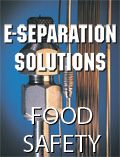Food Safety Analysis
The wide variety of matrices, the number of potential contaminants, and the pressure of meeting regulatory standards all contribute to the difficulty of food safety analysis.

The wide variety of matrices, the number of potential contaminants, and the pressure of meeting regulatory standards all contribute to the difficulty of food safety analysis. Participants in this Tech Forum are William Goodman of PerkinElmer, Julie Kowalski of Restek, and Gerry Broski of Thermo Fisher Scientific.
What are the greatest challenges in food safety analysis?
Goodman:Food safety analysis as a whole is a large and complicated arena, thus it is difficult to identify one or even a few challenges as being the greatest. From a chromatography and mass spectrometry perspective, some of the bigger challenges that we see are:
• Sample throughput — there are a huge number of samples to screen thus efficient analyses are important.
• Variety of potential contaminants — you never know what is going to cause the next problem, many times the contamination is something expected such as E. coli; however, when problems such as melamine in baby formula and diethylene glycol in toothpaste arise it highlights the importance of comprehensive and sensitive techniques.
• The matrix — as with any natural product the matrix is always very complex and dynamic. The challenge is removing the unnecessary aspects while recovering the compounds of interest.
Kowalski:It would be great if we could detect contaminants at low levels and do so quickly. Instrumentation has evolved to help us do this, but what remains challenging is doing it in complex matrices. Developing methods that are fast and sensitive in a single matrix can typically be accomplished. What is challenging is developing methods that are robust enough to work in diverse matrices.
Broski:The analysis of food to ensure safety presents myriad challenges: however, I would expect that the single greatest challenge is unknown emerging threats. Depending on the situation, the investigator is either looking for a specific contaminant using a targeted analysis, or they are looking for an unknown using a screening method. It is estimated that there are ›50,000 unique food matrices and each one requires a method that can effectively and efficiently extract the analyte of interest, such as chemical contaminants or residues, microbiological organisms, or physical contaminants. Going from a reactive mode to an anticipatory mode of operation will also be required to respond to new emerging threats to our food supply.
Another significant challenge is keeping abreast of changes in regulations and the impact of the regulations to a testing lab. China implemented new food safety legislation earlier this year, the US government is set to sign new food safety legislation, and the EU and other countries are constantly changing MRLs and revising compounds of interest. The dynamics of food safety regulation requires constant monitoring.
How have changes in regulatory standards affected food safety analysis?
Goodman:The regulatory standards are constantly creating more comprehensive testing requirements and driving lower detection limits; this is a trend that I think will continue. As instrument providers we are constantly driving to create solutions that are faster and more sensitive.
Kowalski:In a global food supply, it can be easy to feel lost in the ever-changing regulatory environment. Different standards apply for different areas of the globe. It appears work is being done to apply comparable standards to regions considered to have substandard food safety practices. This push toward a universal food safety standard is also heavily influenced by the desire to import and export foodstuffs.
Broski:The US has a new food safety bill in Congress with provisions for increased testing and analysis. In the EU, the trend has been toward the harmonization of standards for contaminants such as pesticides, chemicals, and veterinary medicine residues.
To meet these harmonized standards, labs that currently use only chromatography for analysis will have to upgrade to mass spectrometry for increased confirmation of the targeted and nontargeted compounds. The same is true with trace metals analysis migrating towards increased speciation for confirmation. The EU is assessing the risk of nanoparticles in the food chain, and regulations are developed, systems will need to be developed which will not only measure concentration, but size and shape as well.After the melamine contamination event, the US FDA opened offices in China to monitor the food safety and also to assist in training for food safety, meaning we are looking at monitoring both ends of a supply chain, the export and the import. Japan has implemented a stringent positive list system for agricultural chemicals since May 29, 2006, to ensure the food safety in the country. In this system, about 820 substances including pesticides, veterinary drugs, and feed additives have been set up for MRLs. For those agricultural chemicals without MRLs, 0.01 ppm will be adopted. These requirements call for increased sensitivity and analysis capability.
What new demands were placed on food safety analysis in the wake of the melamine scare?
Goodman:Following the melamine scare I have seen two trends:
• That the testing industry is considering a wider scope of potential contaminants beyond expected contaminants such as pesticides and microbes.
• The food companies are considering where their raw materials are coming from and validating the quality of overseas suppliers. This is pushing quality and safety testing up the supply chain involving new people in the analytical process.
Kowalski:The ability to move quickly is essential to dealing with a food safety issue and melamine proved challenging in this respect. Determining what exactly to test for was not clear-cut. Not being certain about the mode of toxicity was a question that had to be answered in order to develop an analytical test that had meaning. A second challenge was to address the ever-expanding list of matrices; what started with pet food and infant formula has grown into a long list of commodities that people would like to test, even including pharmaceuticals.
Broski:The deliberate adulteration of food products and additives with melamine was a watershed event in food safety in that it was the first widespread deliberate contamination of food using an “unexpected” contaminant that was not detected by customary, (Kjeldahl), testing methods. Melamine would typically not be expected in food; therefore food testing laboratories were generally not testing for melamine. The fact that melamine was found in food and caused significant health and mortality issues, forced people to realize that food was vulnerable to deliberate contamination by unexpected contaminants. From that point forward we were forced to rethink our expectations of safe food production, and now understand increased vigilance is needed to test food for unknown contaminants.
Are there any techniques or instrumentation that could be better utilized in food safety analysis?
Goodman:I think that in the coming years there will be a need for faster and simpler types of analyses that can be completed in the field or at the production line. Additionally, there will be a need for more comprehensive techniques, which allow better detection of unknowns; technologies such as TOF MS will facilitate this.
Kowalski:The bottleneck for food analysis still seems to be sample preparation. Anything that is effective, but decreases the cost of sample prep, mainly time, would be a great advantage. Automation may be part of the answer to speed sample processing.
Broski:High resolution/mass accuracy mass spectrometry is rapidly being adopted for screening, quantitation, and confirmation of contaminants such as pesticides. Because they enable exact mass determination, instruments using orbitrap technology, providing resolution up to 1:100,000, or TOF technology, which provide somewhat lower resolution (up to 1:40,000), enable the investigator to accurately identify compounds that would be indeterminate to LC–MS instruments of lower resolution.
What is the future of food safety analysis?
Goodman:As was mentioned above, there is always going to be a regulatory driver for more thorough testing and a drive for cost reduction in the supply chain. This requires sensitive, easy-to-use, and fast instrumentation, which will allow for detection of a wide range of potential contaminants at lower and lower levels. There is also a huge need for fast and easy sample preparation techniques that will effectively eliminate matrix and improve detectability of potential contaminants.
Kowalski:Of course, there is always a desire for analyses that are faster and look for everything under the sun at lower and lower levels. This is a goal that is strived for in every field — we all want to do it faster, better, and cheaper. Outside of this construct lies an area that could change the future of food safety analysis: knowing the unknown. A proactive, predictive element to food safety could minimize the issue of unexpected contaminants.
Broski:As the sensitivity of instrumentation has increased, the possibility of profiling food will require the need for sophisticated analysis software containing food profile databases that will filter out anomalies such as contaminants. Regarding the technology itself, it is clear that global commerce and expectations of in-situ analysis will drive the development of portable devices for food testing. Margaret Hamburg, the new head of the FDA, was quoted as saying that more on-site or point of entry (POE) testing is required and would increase the safety of the food supply. Noncontact “guns” are already commercially available for metal content analysis, such as detecting lead in children’s toys. Portable spectrometers are being used in the pharmaceutical industry for ingredient confirmation. Since the need is apparent for portable, rapid testing, the technology for a portable food safety analyzer is most likely in development at this moment somewhere in the world, and will complement laboratory testing.
If you are interested in participating in any upcoming Technology Forums please contact Group Technical Editor Steve Brown or Associate Editor Meg Evans for more information.
Analytical Challenges in Measuring Migration from Food Contact Materials
November 2nd 2015Food contact materials contain low molecular weight additives and processing aids which can migrate into foods leading to trace levels of contamination. Food safety is ensured through regulations, comprising compositional controls and migration limits, which present a significant analytical challenge to the food industry to ensure compliance and demonstrate due diligence. Of the various analytical approaches, LC-MS/MS has proved to be an essential tool in monitoring migration of target compounds into foods, and more sophisticated approaches such as LC-high resolution MS (Orbitrap) are being increasingly used for untargeted analysis to monitor non-intentionally added substances. This podcast will provide an overview to this area, illustrated with various applications showing current approaches being employed.





